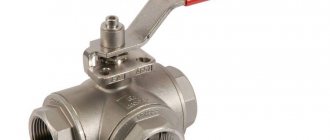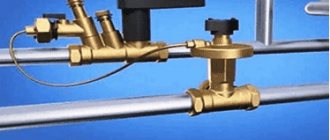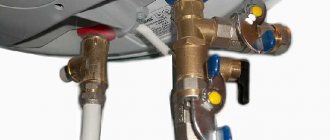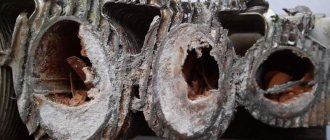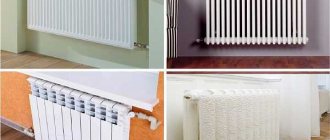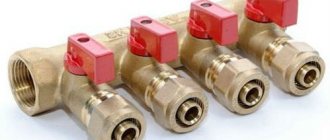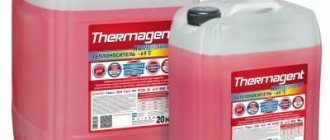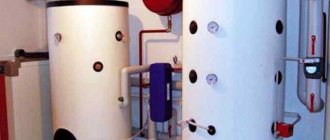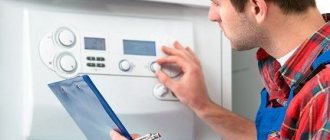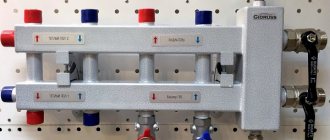Danfoss ASV-PV, DN15, article number - 003Z5501.
A differential pressure regulator is a special fitting used in piping systems. With this device, the pressure difference of the liquid medium is automatically maintained at the level of preset values. The regulation of differences is carried out by a valve, the flow area of which changes based on pressure parameters.
Types of water pressure regulators
There are five types of water pressure regulators:
- Flow-through:
- Membrane;
- Piston;
- Automatic;
- Electronic.
Based on the principle of installation and use, there are two types of regulators:
- Up to yourself;
- After myself.
The regulator “before itself” equalizes the pressure in the system located in front of it. Such regulators are used where it is necessary to protect the pipeline and plumbing fixtures from water hammer and high pressure. For example, in heating and cooling systems.
The water pressure regulator “after itself” equalizes the water pressure at the outlet. Such regulators are used where water is supplied to the end consumer:
- In the water supply system in the apartment;
- Irrigation systems;
- Wells, pumps, pump rooms;
- Water supply for technical needs.
As for the materials from which water pressure regulators are made, they can be:
- Cast iron;
- Steel;
- Brass;
- Titanium.
They also differ in configuration. Options may include:
- Pressure gauge;
- Mechanical cleaning filter;
- Ball Valves;
- Spare set of gaskets;
- Air vent.
The principle of operation of a membrane water pressure regulator after itself
This pressure regulator consists of the following parts (see figure):
- A – Valve inlet;
- B – Valve output;
- C – Connection to the membrane chamber;
- D – Membrane chamber;
- E – Spring;
- F – Locking disc.
“Afterwards” water pressure regulator device.
It works like this:
- When the water pressure after the locking disc increases, it fills the membrane chamber;
- As the membrane chamber fills, the membrane presses on the rod connected to the locking disc;
- The disc closes the hole in the valve and the pressure after the valve decreases.
As the pressure decreases, the following happens:
- Water from the membrane chamber returns to the valve through the pipe;
- The pressure in the chamber decreases, the spring pulls back the locking disc;
- The flow of water through the hole in the valve increases and the pressure rises.
The principle of operation of the water pressure regulator after itself.
How does a membrane water pressure regulator work?
The design of a water pressure regulator upstream is more complex than one that operates on the downstream principle. It consists of (see figure):
- A – Valve inlet;
- B – Valve output;
- C – Branch pipe from the valve inlet to the pilot regulator;
- D – Branch pipe from the membrane chamber to the valve outlet;
- E – Pilot regulator;
- F – Membrane chamber;
- G – Locking disc.
The water pressure regulator device is up to you.
The principle of operation of the water pressure regulator can be divided into two stages: increasing the pressure and decreasing it. When the valve inlet pressure increases, the following occurs:
- Water flows through the pipe from the inlet to the valve into the pilot regulator, where it presses on the spring;
- The pilot regulator opens the hole between the membrane chamber and the pipe to the outlet of the valve;
- Water leaves the membrane chamber, the spring pulls back the locking disc;
- The pressure at the valve inlet decreases.
When the pressure at the valve inlet decreases, the following occurs:
- Water from the pilot regulator is returned through the pipe to the valve inlet;
- The pilot regulator spring expands and the hole between the membrane chamber and the pipe to the valve inlet opens;
- The membrane chamber is filled with water and the locking disc closes the hole;
- The pressure at the valve inlet increases.
The principle of operation of the water pressure reducer.
Replacement
Replacing the gearbox is a disassembly and installation procedure.
Procedure:
- turn off the water and relieve pressure by opening the tap;
- remove the defective device;
- install a new device, connect the drain hole to the sewer;
- supply water, set the operating mode.
It is best to buy the same model so that no problems arise when replacing. But if replacement is still necessary, our article will make the task easier.
Piston water regulator: operating principle
In a piston regulator, the balance of incoming and outgoing pressure is achieved by a spring pushing the piston (see figure below). It works like this:
Water enters the first chamber, from which it passes into the second through an opening. When the pressure in the second chamber increases, it pushes the piston, which compresses the spring. The locking disc closes the passage hole and the pressure in the second chamber decreases.
When the water pressure decreases, the pressure in the first chamber decreases. The spring pushes out the piston and locking disc. Through the passage hole, water enters the second chamber and the pressure increases.
The device of a piston water pressure regulator.
The flow force can be adjusted by moving the spring and piston through the second chamber. For this purpose, such devices have an adjusting screw. By tightening it, you reduce the outlet pressure, and by unscrewing it, you increase it.
Repair
As a rule, gearbox repair consists of restoring the functionality of the spring and valve.
Procedure:
- turn off the water, drain the excess from the tap and remove the gearbox;
- disassemble it and remove defective parts;
- clean the body, inspect the structural elements and identify failed parts;
- replace or restore the condition of elements. It is easier to replace the spring, but it is better to try to restore the piston;
- assemble the device, install it in place and supply water.
Full information about DIY repairs is here.
Attention! Membrane models, most often, cannot be repaired. Finding a replacement membrane is extremely difficult. This must be kept in mind when purchasing a device.
How does an automatic pressure regulator work?
In its operating principle, an automatic regulator is similar to a piston regulator. The only difference is that the membrane acts as a piston (see figure), and the damper is spring-loaded.
Automatic membrane pressure regulator device.
When the pressure of incoming water increases, it pushes the membrane upward. It pulls the flap and the hole is partially blocked. In this case, the pressure of the outlet flow decreases.
As the pressure of the incoming flow decreases, the membrane moves down, lowering the damper. The duct opening opens more and the outlet pressure increases.
A distinctive feature of automatic diaphragm valves is the presence of a second spring on the damper. It allows you to more accurately regulate pressure. The required outlet pressure is adjusted using the adjusting screw.
Cleaning
To clean you need:
turn off the water;- open the tap to remove remaining water;
- disassemble the gearbox, remove the strainer and clean it with a wire brush;
- Clean the inside of the case with a thin brush. You can use household chemicals;
- Reassemble the gearbox in reverse order and supply water.
If the quality of the network water is low, cleaning will have to be done quite often. Additional cleaning methods can be found here.
Electronic regulators
At the moment, these are the most advanced and accurate devices. They can work in modes before and after themselves. Their operating principle is as follows:
- A sensor at the inlet and outlet determines the water pressure;
- Signals from the sensors enter the control device;
- The device activates the locking mechanism or regulates the operation of the circulation pump.
Electronic water pressure regulators allow you to set the settings as accurately as possible. Due to this, they are used in systems designed for specific needs. But their cost is also high.
Electronic water pressure regulator.
Choose wisely
When choosing a water pressure regulator, you need to pay attention to the following:
- Maximum operating pressure of the device (it should be 20-30% higher than the maximum in the system);
- The diameter of the inlet and outlet must exactly match the diameter of the system pipes;
- The larger the pressure adjustment range, the better, but it is worth taking into account the features of the heating or water supply system;
- Before you settle on a type of regulator, make sure it will suit your needs. The option that is suitable for a water supply system cannot always be used in a heating system;
- When choosing an electronic regulator to connect to the circulation pump, check their compatibility.
Manufacturers
Among the leading manufacturers of gearboxes, Italian companies predominate. They are traditionally famous among manufacturers of such products. However, the Russian company Valtec or the American Honeywell are no less famous.
To more clearly compare products from different manufacturers, let's create a table:
| Brand | Pressure (max) | Temperature (max) | Setting limits (Bar) | Pressure gauge | Adjustment type |
| Valtec | 16 At | 40° — 70° | 1,5-6 | Eat | Pen |
| Honeywell | 25 At | 40° — 70° | 1,5-6 | Eat | Pen |
| Watts | 10 At | 30° | 1-6 | Eat | Pen |
| Herz | 10 At | 40° | 1-6 | Eat | Pen |
| Caleffi | 10 At | 80° | 1-6 | Eat | Pen |
| Giacomini | 16 At | 130° | 1-5,5 | Eat | Pen |
Looking at the table, you can see that the parameters of all household devices are more or less similar. Only the maximum temperature and operating pressure differ. This makes it easier for users to choose the right device.
Correct installation of the water pressure regulator
Installing the pressure regulator is easy. When installing it or inserting it into the system, everything is done in the same way as when installing any plumbing fixture or shut-off valve. But there are certain rules that you should know.
In the apartment
Installing a water pressure regulator in an apartment requires compliance with the following rules:
- The regulator must be installed at the entrance to the heating system and regulate the pressure “after itself”;
- Before and after the regulator, it is necessary to install (if they are not present) ball valves in case of need for dismantling;
- Be sure to install a coarse filter in front of the regulator;
- If a conventional or automatic air vent is installed, the regulator must be located after it.
- Strictly observe the direction of water flow;
- Do not install the water pressure regulator “upside down”;
- The closer the regulator is to the riser, the better.
In a private house
When installing a pressure regulator in a private home, consider the following:
- You should be able to dismantle the regulator - install ball valves in front of it and after it;
- The pressure regulator “before itself” is installed in front of the pump, “after itself” - behind the pump;
- If the system does not have a coarse filter, install it in front of the regulator and circulation pump;
- If it is not water that circulates in the system, but a coolant, make sure that it will not damage the mechanisms and gaskets of the device, read the specification for the coolant;
- Observe the direction of flow when installing the regulator;
- Do not install the device upside down.
Heating temperature control devices
Electronic thermostat
Most often it is necessary to change the temperature parameters in the heating system. This can be done both comprehensively for the entire network, and for each device separately. Therefore, in critical sections of the highway, a mechanical temperature controller for heating or its electronic equivalent is needed.
What tasks should these devices perform? First of all, control and timely change of temperature in the system. Depending on the design and area of application, temperature controllers for radiators and the entire heating supply in general can be of several types:
- Controllers for the operation of the entire heating system . These include a weather heating regulator, which is connected directly to the boiler or distribution unit of the system;
- Zone control thermostats . This function is performed by the heating battery regulator, which limits the flow of coolant depending on the current temperature readings.
Each of these classes of devices is cast structurally and has its own individual installation scheme. Therefore, to properly configure the heat supply, it is necessary to understand the specifics of all types of thermostats.
Experts recommend purchasing heating radiators with a temperature controller. This will not only save money, but will eliminate the possibility of buying the wrong model.
Mechanical heating thermostats
Design of a mechanical thermostat
The mechanical regulator of the heating battery is the simplest and most reliable device for semi-automatic and automatic control of the heating of the radiator surface. It consists of two interconnected units - shut-off valves and a control thermal head.
The housing of the control part contains a heat-sensitive element that changes its dimensions under the influence of temperature. It is connected to a needle valve that limits the flow of coolant. To control changes in valve position, the apartment heating regulator has a spiral spring, which is connected to an adjustment knob. Turning it increases or decreases the degree of pressure of the spring against the heat-sensitive element, thereby setting the response temperature of the device.
The advantages of using a mechanical temperature controller for heating are as follows:
- Possibility of adjusting the heating of an individual radiator without affecting the parameters of the entire system;
- Easy installation and maintenance. Even a non-specialist can do this work. It is only important to read the instructions for installing temperature controllers in heating radiators;
- The design is designed for radiators of all types - steel, aluminum, bimetallic and cast iron. However, installing a regulator in a cast iron heating radiator is not always advisable. This material has a high heat capacity.
The main difficulty in installing heating radiators with a temperature controller is the correct location of the control element. Do not allow hot air from pipes or batteries to affect the temperature-sensitive element. This will cause it to malfunction.
The technology for installing a mechanical temperature controller for heat supply may vary depending on the design of the battery and the method of its connection to the heating.
Electronic heating programmers
Heating programmer
Weather heating controllers have significantly more functionality. They consist of an electronic control unit that can be connected to other heat supply elements - boiler, thermostats, circulation pumps.
The operating principle of electronic heating controllers in an apartment differs from mechanical ones. They process the readings of built-in or external thermometers to transmit commands to control elements. So, when the temperature in a separate room changes, a command is sent to the servo drive of the heating radiator regulator, which in turn changes the position of the needle valve.
The specifics of the functioning of the weather heat supply regulator are expressed in the following nuances:
- Ensuring a constant supply of electricity to operate the device;
- Connection to other heating elements can be made if the heating regulator device for the apartment has the appropriate connectors;
- Changing the controller operating parameters depends on the factory settings. Some models for heat supply radiators with a temperature controller have unchangeable settings. Complex programmers are characterized by flexible software.
To organize remote control of the heating regulator in the house, you can install a GPS module. With its help, data on the system state will be transmitted to the user in the form of SMS. In the same way, reverse heat supply control is carried out. A manual heating temperature controller does not have such a function a priori.
Temperature controllers for heating radiators are configured based on the calculated parameters of the system. Otherwise, the device may not function correctly.
Thermostats in heating manifolds
Thermostats in the heating manifold
In addition to installing manual heating temperature regulators in batteries, they are used to complete the manifold heat supply. Their installation is carried out both in the central distribution combs and in the control unit of the water heated floor system.
Unlike regulators for heating radiators, in the collector group they perform the function of controlling the volume of coolant flow into individual heat supply circuits. Therefore, the requirements for the design and its functionality are somewhat higher than for devices designed to include batteries.
There are several types of thermostats for collector groups:
- Manual heat supply temperature controllers . Structurally, they are no different from similar battery devices. The difference is in the size of the connected pipe and the operating temperature range. They are inconvenient to use, since you have to manually configure parameters for a separate circuit;
- Thermostats with servo drive . They are often connected to an external control module. The damper position changes only when a command is received from the programmer. Options are available for installing a remote temperature sensor. This is most often done to organize mixing units.
Installation and operation of such thermostats will allow you to achieve precise adjustment of individual heating circuits. In this way, you can save on energy use costs and optimize the operation of the entire system as a whole.
There are two types of thermostats for collector heating - with removable servo drives and stationary ones. The choice depends on the required functionality of the system.
